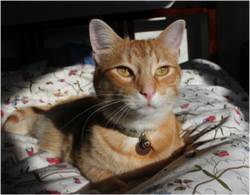Inappropriate Urination in Cats - How You Can Help Keep Cats in their Homes!
By Sessaly Craft, UW Veterinary Student, Dane County Humane Society Intern, and UW Shelter Medicine Club President

Inappropriate urination outside the litterbox is a common reason that healthy cats are surrendered to animal shelters. This article aims to educate readers on the causes of inappropriate urination and how to manage it in the hopes that shelter staff can educate cat owners on how to stop inappropriate urination so the cat does not have to be surrendered.
The first step in stopping inappropriate urination is to understand the cause: is it behavioral or medical? First, a medical problem should be ruled by having the cat examined by a veterinarian. Examples of medical problems that cause a cat to urinate outside the litterbox are Feline Idiopathic Cystitis (aka Feline Lower Urinary Tract Disorder, or FLUTD), bladder stones, diabetes and urinary tract infections. These conditions cause pain, an increased sense of urgency, or larger volumes of urine. After medical causes have been ruled out, the inappropriate urination is likely being caused by a behavioral problem.
The ASPCA states the top 20 most common reasons a cat will urinate outside of the litterbox:
The third question to ask is: how many litterboxes are there per cat in the household? There should be at least one more litterbox than the number of cats. For example, if there are two cats in a household there should be at least 3 litterboxes. If the cats are territorial or prevent the other cats from gaining access to the litterbox, more litterboxes may be needed.
The fourth question to ask is: how much access does the cat have to the litterbox? There may be enough litter boxes in the house for every cat, but if they are all in the basement of a three-story home then they are not strategically placed. Cats need privacy when urinating and defecating, so place the litterbox in a quiet, low-traffic area. Avoid placing it near toilets, sinks, washers, and dryers that make sudden loud noises that can scare cats. Additionally, provide your cat with a large enough litterbox for them to be comfortable in – consider upgrading to a larger box. On the same note, avoid use of litterboxes with lids and tops as these can be too confining as well.
The first step in stopping inappropriate urination is to understand the cause: is it behavioral or medical? First, a medical problem should be ruled by having the cat examined by a veterinarian. Examples of medical problems that cause a cat to urinate outside the litterbox are Feline Idiopathic Cystitis (aka Feline Lower Urinary Tract Disorder, or FLUTD), bladder stones, diabetes and urinary tract infections. These conditions cause pain, an increased sense of urgency, or larger volumes of urine. After medical causes have been ruled out, the inappropriate urination is likely being caused by a behavioral problem.
The ASPCA states the top 20 most common reasons a cat will urinate outside of the litterbox:
- The cat is suffering from a medical problem involving the urinary tract.
- The cat experiences a bout of geriatric constipation.
- The caretaker does not keep the box as clean as the cat wants it to be.
- The owner changes the brand or type of litter.
- The owner changes the location of the litterbox.
- The owner switches to deodorized or perfumed litter.
- The owner buys a new box and throws out the old one.
- The owner cleans the litterbox with too harsh a cleaning product.
- The location of the litterbox is too busy or not private enough for the cat.
- The home is too large for just one litterbox.
- The cat inadvertently gets locked out of reach of the litterbox.
- The cat is kept from using the litterbox by another animal in the house.
- There are too many cats and not enough litterboxes.
- There are too many cats and not enough territory.
- Stray cats can be seen/smelled near the cat’s territory.
- The unneutered male cat has come of age and is marking his territory.
- The unspayed female is in heat and advertising for suitors.
- Over time, the cat has developed an aversion to the texture of the litter.
- The cat was never properly trained to use the litterbox in the first place.
- The cat is stressed by a change in routine or environment, including a new baby, new furniture, work schedule changes, vacations, overnight guests or a move.
The third question to ask is: how many litterboxes are there per cat in the household? There should be at least one more litterbox than the number of cats. For example, if there are two cats in a household there should be at least 3 litterboxes. If the cats are territorial or prevent the other cats from gaining access to the litterbox, more litterboxes may be needed.
The fourth question to ask is: how much access does the cat have to the litterbox? There may be enough litter boxes in the house for every cat, but if they are all in the basement of a three-story home then they are not strategically placed. Cats need privacy when urinating and defecating, so place the litterbox in a quiet, low-traffic area. Avoid placing it near toilets, sinks, washers, and dryers that make sudden loud noises that can scare cats. Additionally, provide your cat with a large enough litterbox for them to be comfortable in – consider upgrading to a larger box. On the same note, avoid use of litterboxes with lids and tops as these can be too confining as well.

The fifth question to ask is: have you changed anything about the litterbox and its environment? A different litter type (clay, clumping, etc)? A different box? Box liners? The location? Are you cleaning it less frequently? A scented litter? Depth of the litter? Even the slightest changes can cause a cat to urinate outside the litterbox. Additionally, you can try switching litters as the cat may not longer like the litter being used.
The sixth question to ask is: is there anything new causing the cat stress? New family members or pets, changing furniture or moving, nearby outdoor cats moving in to the cats territory, and any other change in the environment and routine of a cat can cause stress and lead to inappropriate urination. In addition to reducing stressors, pheromones (like Feliway) can be used to soothe cat and decrease anxiety.
Finally, after addressing the original problem, discourage the cat from urinating in inappropriate areas. Try placing a litterbox directly on the spot where your cat has been urinating. Clean up any urine using an enzyme-based cleaner that will remove the smell, as cats are attracted to previously soiled areas. Limit the cat’s access to the site of inappropriate urination, or make it undesirable for them (example: place double stick tape on carpeting). If your cat urinates outside of the box in front of you, do not punish or yell at the cat as this will only lead to more behavioral problems.
Sources
Best Friends Animal Society
ASPCA
http://vet.osu.edu/assets/pdf/hospital/behavior/felineInappropriateElimination.pdf
The sixth question to ask is: is there anything new causing the cat stress? New family members or pets, changing furniture or moving, nearby outdoor cats moving in to the cats territory, and any other change in the environment and routine of a cat can cause stress and lead to inappropriate urination. In addition to reducing stressors, pheromones (like Feliway) can be used to soothe cat and decrease anxiety.
Finally, after addressing the original problem, discourage the cat from urinating in inappropriate areas. Try placing a litterbox directly on the spot where your cat has been urinating. Clean up any urine using an enzyme-based cleaner that will remove the smell, as cats are attracted to previously soiled areas. Limit the cat’s access to the site of inappropriate urination, or make it undesirable for them (example: place double stick tape on carpeting). If your cat urinates outside of the box in front of you, do not punish or yell at the cat as this will only lead to more behavioral problems.
Sources
Best Friends Animal Society
ASPCA
http://vet.osu.edu/assets/pdf/hospital/behavior/felineInappropriateElimination.pdf
